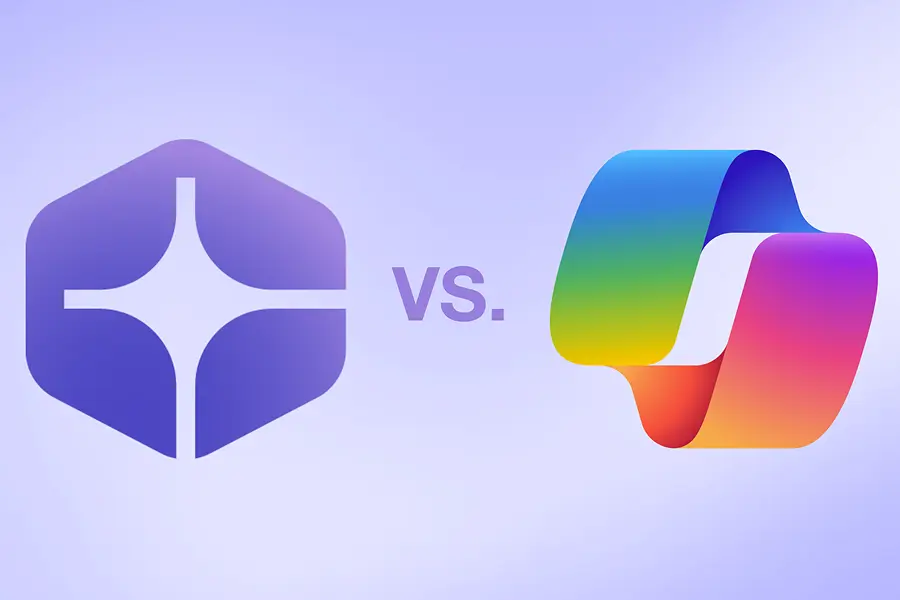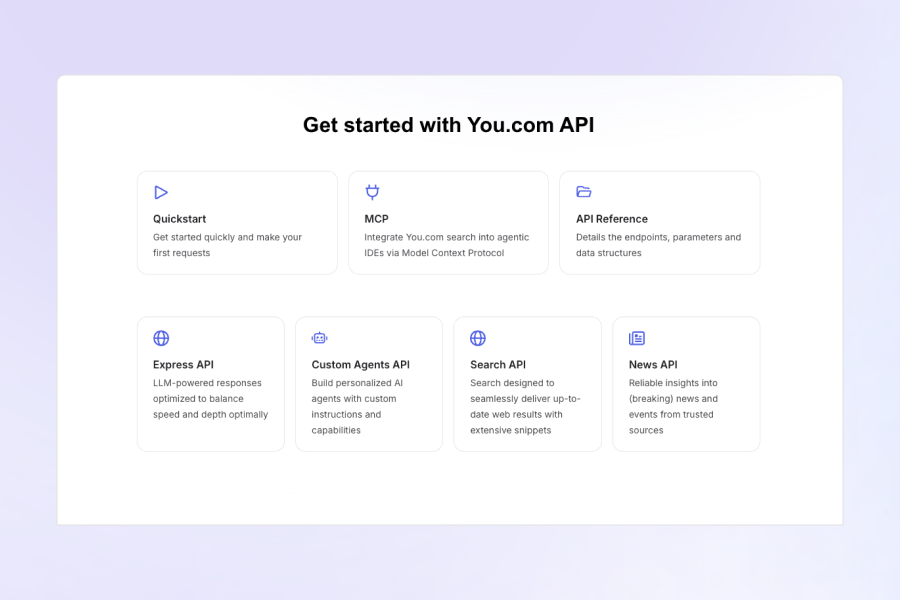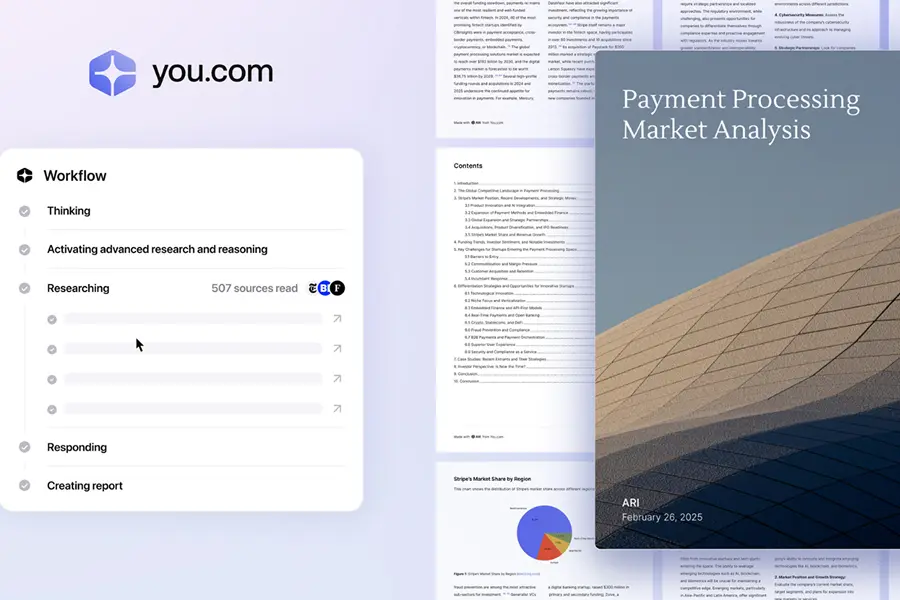AI is the innovation engine for enterprises. It powers copilots, chatbots, and intelligent applications that transform how employees work and how customers engage. As organizations move from early experiments to large-scale deployments, many are discovering something crucial. Every great AI experience starts with great search.
Whether you're building a retrieval-augmented generation (RAG) pipeline or connecting an large language model (LLM) to trusted internal data, a Web Search API sits at the center. It determines how quickly your AI finds the right information and how much you can trust the answers it delivers.
In this guide we will explore seven key elements enterprises should look for in a Web Search API built for the AI era.
What are Web Search APIs?
A Web Search API connects your applications and AI systems to live, relevant information without the complexity of building or maintaining your own search infrastructure. It provides a simple way to access and retrieve up-to-date data from across the web or internal sources, keeping your applications and models informed in real time.
In modern enterprises, Search APIs serve as the retrieval layer for LLMs and intelligent applications, ensuring responses are accurate, explainable, and grounded in current information.
With a Search API, enterprises can:
- Deliver accurate, consistent, relevant results across every interface
- Connect internal and external data securely without duplicating infrastructure
- Give LLMs access to trusted, real-time context instead of static training data
- Scale retrieval efficiently without sacrificing speed or governance
In short, a Search API keeps your AI systems aligned with the world as it changes and makes information findable, trustworthy, and ready for use.
7 Elements to Look For in a Web Search API
1. Real-Time, Live Web Data
AI is only as good as the information it can access. When your RAG pipeline pulls outdated pricing data or your chatbot references last quarter’s policies, customer and employee trust in AI erodes. A great Web Search API should deliver fresh, continuously updated data so your AI always reflects what’s happening now.
Real-time search makes your systems responsive to change. So things like new SEC filings, product updates, or breaking news can flow into your AI prompts within minutes, keeping insights relevant and decisions timely.
Look for APIs that support continuous crawling with configurable refresh schedules. The best systems prioritize content intelligently—refreshing fast-changing sources like news and market data every few minutes while updating documentation or reference pages less frequently. This keeps costs manageable while ensuring critical information stays current.
Choose providers that let you set custom refresh rates or trigger on-demand crawls when specific sources need instant updates.
2. Citation and Source Transparency
When AI informs critical business decisions, knowing where the information comes from is just as important as the result itself. Enterprises need search systems that show their work — making it clear which sources shaped each answer and when they were last updated.
And a simple list of URLs isn’t enough. Enterprise-grade Search APIs should enrich every result with structured metadata such as domain authority, publication date, and content freshness. Some even include bias detection or confidence scores that help AI systems and users prioritize credible, authoritative sources over unverified ones.
To prevent that, many enterprises are building citation visibility directly into their AI guardrails so every insight can be traced and verified. This approach ensures transparency throughout the workflow. Each summary connects directly to its original sources, creating a clear record of where the information came from and how it was used.
When customers, auditors, or executives need to understand how an output was formed, the reasoning is easy to follow and strengthens confidence in both the process and the results.
3. Enterprise Security and Compliance
In the AI era, a Search API acts as a gateway between sensitive internal data and powerful language models. One misconfigured permission can expose customer records or leak proprietary research.
Modern Search APIs need granular, context-aware access controls. For instance, a sales assistant should see CRM data but not HR files. A support bot should access product documentation but not financial forecasts. The most secure enterprise platforms use attribute-based access control (ABAC) to evaluate user role, department, and geography before returning results.
Equally important is data governance and compliance. Enterprise-grade providers should enforce zero data retention policies, meaning your queries are never stored, trained on, or shared. They should also hold certifications that match industry standards, such as SOC 2 Type II, HIPAA, PCI DSS, or FedRAMP, helping enterprises meet audit requirements without months of security reviews.
Together, access control and compliance ensure your AI systems can search freely while keeping sensitive information fully protected.
4. Scalability and Uptime
AI workloads are unpredictable, shifting from routine requests to massive spikes in traffic within seconds. A true enterprise Search API must scale effortlessly, maintaining consistent sub-100 ms response times and low error rates even under heavy demand.
Global reach matters just as much as speed. Distributed edge infrastructure and regional data residency ensure low latency and compliance across continents, so performance stays reliable no matter where your users are.
Uptime measures how consistently a service stays available. Even brief outages can interrupt AI workflows, disrupt users, and erode trust. Look for providers that deliver 99.99 percent or higher uptime, supported by transparent SLAs, real-time status dashboards, and detailed post-incident reports. The best APIs treat reliability as a core product feature, not a checkbox.
5. API Design and Developer Experience
A Search API should be as intuitive to build with as it is powerful. Clear documentation and consistent endpoints reduce friction and help teams integrate faster.
Good design starts with predictable REST or GraphQL structures, clear response formats, and helpful error messages that make debugging simple. Documentation should go beyond reference tables to include quick-start examples, architecture diagrams, and code snippets in multiple languages so developers can move from prototype to production quickly.
The best APIs support diverse teams with libraries for major languages and frameworks, including Python, JavaScript, Go, and Java. Sandbox environments and testing tools make experimentation easy, while strong version control ensures stability as your applications evolve. A well-designed API saves development time and helps your team focus on innovation instead of integration.
6. Performance and Latency
In AI applications, every millisecond counts. A chatbot that makes multiple search calls per response can quickly turn small delays into seconds of lag, breaking the illusion of real-time interaction. Consistent, low-latency performance determines whether your AI feels responsive or sluggish.
True performance goes beyond average response time. Look at P95 and P99 latency metrics, which measure how the API performs under peak load. A provider with a 30-millisecond average may still have one percent of queries taking two seconds or more. Enterprise-grade APIs maintain stability across all percentiles through intelligent caching, optimized indexing, and dynamic resource allocation.
Efficient APIs also account for query complexity. Semantic search, filtering, and aggregation all add processing time. Top providers offer query-level controls so teams can balance precision and speed, automatically adjusting when workloads exceed latency thresholds.
Finally, network optimization plays a major role in real-world performance. Technologies such as connection pooling, response compression, and persistent connections minimize overhead and keep results fast, even when your AI makes hundreds of queries per minute.
7. Integration Flexibility
A Web Search API should fit seamlessly into your existing AI infrastructure. Whether your organization runs workloads in AWS, Azure, on-premise data centers, or a mix of all three, the right API connects wherever your data and models live.
Integration flexibility starts with deployment. Enterprise APIs should support hybrid and multi-cloud architectures, allowing teams to process data close to where it’s stored. This ensures fast retrieval for RAG pipelines, internal search tools, and agentic systems without forcing new infrastructure decisions.
Connectivity also drives time to value. Native integrations with enterprise systems like SharePoint, Confluence, and Salesforce eliminate custom ingestion work. Pre-built connectors for data lakes, vector databases, and cloud storage help teams sync content continuously and keep context fresh across applications.
Finally, flexibility protects against lock-in. APIs that support open standards and export data in interoperable formats make it easy to integrate with evolving AI stacks, model families, and retrieval frameworks. The most adaptable solutions meet you where you are today and scale with the systems you build next.
Final Thoughts
Building intelligent, AI-driven experiences starts with a strong retrieval foundation. The most effective enterprise Search APIs combine real-time data, transparency, scalability, and developer-friendly design to ensure every query delivers fast, accurate, and trustworthy results.
You.com’s Web Search API gives enterprises that foundation. It delivers live, reliable web data optimized for AI applications, complete with verifiable sources and enterprise-grade security. Developers can integrate it quickly through flexible endpoints while data teams gain the confidence that every response is grounded in current, trustworthy information.
You.com powers the next generation of enterprise AI experiences that are faster to deploy, easier to scale, and built for accuracy from the ground up.
Start Building Now
Subscribe to get a free trial of our Search API and 1,000 calls.




.webp)



.png)
%20(2).png)

.png)


